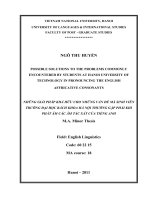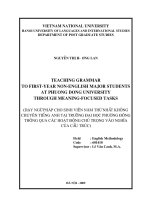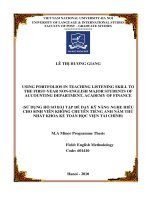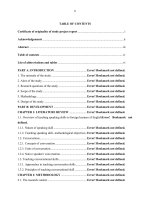Using oral activities to teach grammar communicatively to first year non English major students at Vietnam University of Commerce
Bạn đang xem bản rút gọn của tài liệu. Xem và tải ngay bản đầy đủ của tài liệu tại đây (139.46 KB, 6 trang )
Using oral activities to teach grammar
communicatively to first year non English major
students at Vietnam University of Commerce
Trần Thị Thu Hiền
Trường Đại học Ngoại ngữ
Luận văn ThS. Chuyên ngành: Theory and methodology of English teaching
Mã số: 60 14 10
Người hướng dẫn: Nguyễn Thu Lê Hằng, MA.
Năm bảo vệ: 2011
Abstract: It is clear to say that the development of language teaching and learning
according to the communicative approach has brought about great changes in teaching
English in Vietnamese Universities in general, and in Vietnam University of Commerce
in particular. Applying the communicative approach to teaching and learning grammar
can be seen as an important element which helps learners reach their new goal in learning
English: for communicative competence. Therefore, grammar is considered to be an
indispensable factor which helps people use its language to communicate successfully.
The existing situation demands a real and positive outlook and appreciation to work out
suitable ways to teach and learn grammar. Accordingly, the study attempts to find out the
current situation, the problems and some suggested solutions of applying oral activities in
teaching grammar communicatively for first year English non-major students at VCU
through survey questionnaires and interview questions. Seeing the difficulties many
teachers encountered and unexplained doubts about the approaches they have been
following, the author decided to do the research on the theme “Using oral activities to
teach grammar communicatively to first year English non-major students at Vietnam
University of Commerce. Basing on her own knowledge and experience, the author
would like to carry out the study on this topic in order to find out how to teach and learn
grammar according to the communicative approach effectively and successfully.
Keywords: Tiếng Anh; Ngữ pháp; Kỹ năng giao tiếp; Phương pháp giảng dạy
Content
PART ONE: INTRODUCTION
1. Rationale of the study
The use of English has been gradually increasing in Vietnam. Also, it has a stable ground in the
Vietnamese education system. English is introduced to the educational curriculum from primary
education (optional) to tertiary education (compulsory). Like many other universities, teachers
and students at Vietnam University of Commerce (VCU) were affected by the traditional
philosophy of teaching and learning. As a result, many students lack the ability to communicate
in oral English after graduation from the university. This fact gives rise to the need of a more
effective method that creates opportunities for the learners, the subject and the centre of the
teaching and learning process to bring full play their intelligence and creativeness.
Over the past few years, the application of the Communicative Language Teaching method has
been widely adopted. This marked the beginning of a major change in the language teaching and
learning at VCU. And students’ grammar as well as communicative ability has been improved
remarkably.
VCU Faculty of English has been newly established for 4 years. Almost all of the teachers were
trained about CLT approach at the University and they fully understood the importance of
communicative grammar lessons among students. Therefore, they made all their effort to apply
many kinds of activities in grammar lessons to encourage students to communicate in studying
grammar in classroom.
As a teacher in the Faculty of English at VCU, from my own observations and experience, I have
noticed that there are many ways to motivate the first year non-major students in grammar
lessons. Among them, the use of oral or speaking activities has been received more emphasis.
Nevertheless, both teachers and students have faced a lot of challenges in implementing and
managing oral activities in grammar lessons. For example, the classroom is too noisy, teachers
sometimes lose control of the class or students tend to switch to use their mother tongue when
not under the teacher’s eyes and so on. Moreover, the teachers’ procedure in organizing speaking
activities in grammar lessons is not very effective.
The above mentioned situation has urged me to conduct a study to investigate teachers’ and
students’ difficulties in implementing oral activities, teachers’ oral activities organization
procedure, and teachers’ strategies to foster students’ English grammar. As a result, I have
decided to carry out the research into “Using oral activities to teach grammar communicatively
for first year non English major students in Vietnam University of Commerce”. This study is
intended to make a modest contribution to an increased understanding of using oral activities in
the grammar lesson at VCU.
2. Aims of the study
The purpose of this study is to explore the reality of the use of speaking activities in the grammar
lesson of 1
st
year students of Economics, Finance and Banking at VCU where the researcher is
serving. More specifically, this study attempts to clarify the procedures of organizing speaking
activities in the grammar lesson of 1
st
year non English major students and to identify strategies
used by teachers to stimulate students’ communicative competence in grammar learning and the
factors bringing about difficulties for the teachers and students in their application of oral
activities. One additional aim is to compare teachers’ practice with students’ expectation. Based
on the findings, the research further seeks to suggest practical recommendations for the
possibility of using speaking activities in grammar lessons of 1
st
year non English major students
at VCU.
3. Scope of the study
Though oral activities are usually applied in the speaking skill, I have chosen to focus on
grammar lessons for the fact that grammar is the first thing that learners learn on the first day of
an English lesson for non English major departments. Moreover, the purpose of studying English
of English non English major students at VCU is to gain an international certificate in
communication, for instance, the TOEIC test. Therefore, this research tends to investigate the use
of oral activities in the grammar lesson. Also, due to the time constraints, this study only
involves a small number of VCU teachers and Economics, Finance and Banking students in their
first year.
4. Research questions
In order to achieve the set goals, the research seeks to answer the following research questions:
- To what degree have oral activities been applied in teaching grammar communicatively to first
year non English majors in Vietnam University of Commerce?
- What problems do teachers meet when using oral activities to teach grammar communicatively
to first year non English major in VCU?
- What are the possible solutions to these problems as suggested by the teachers atVCU?
5. Method of the study
The main method of the study was survey questionnaire, in which two types of questionnaire are
designed and distributed to the learners and the teachers. Furthermore, in order to evaluate the
effectiveness of the suggested approach, the writer collected some information based on her
informal interviews to make sure that the data is more accurate and reliable.
A combination of different methods above will provide reliable data, based on which the
conclusions and suggestions will be made in the next parts.
6. Design of the study
The study consists of three main parts:
The first part, Introduction, provides an overview of the study in which the reasons for choosing
the study will be focused. It also includes the aim, research questions, research methods, scope
and design of the study.
The second part, Development, consists of two chapters:
Chapter one, Literature Review, provides the theoretical background for the thesis. This chapter
includes three main points. The first point deals with the general view on grammar and grammar
teaching approaches. The second point discusses the problems. Finally, the third point discusses
the need for applying oral activities to grammar teaching.
Chapter two, The Study, aims to describe background information about the current teaching and
learning of grammar at VCU and presents the methodology underlying the research including
data collection instruments, procedures. A detailed data analysis and discussions are also given.
The last part, Conclusion, gives a summary and a recommendation for further study.
REFERENCES
1. Allright, R. (1977). Language Learning Through Communication Practice. ELT Documents.
76 (3). (pp. 2 – 14).
2. Celce – Murcia, M. (1991). Grammar Pedagogy in Second and Foreign Language Teaching.
TESOL Quarterly. 3 (25). (pp. 459 – 480).
3. Celce – Murcia, M. (1988). Techniques and Resources in Teaching Grammar. Oxford: Oxford
University Press.
4. Chung, Siaw-Fong. (2005). A Communicative Approach to Teaching Grammar. Theory and
Practice. The English Teacher. 34. Selangor: Malaysian English Language Teaching Association
(MELTA). (pp. 33 – 50).
5. Finocchiaro, Mary and Christopher Brumfit. (1983). The Functional – Notational Approach,
Oxford: Oxford University Press.
6. Friederike Klippel. (1984). Keep Talking – Communicative Fluency Activities for Language
Teaching. Cambridge University Press.
7. Fuyuko Kato (1998). Second Language Acquisition & Pedagogic Grammar. Retrieved from
the World Wide Web:
8. Hammerly, H. (1987). The immersion approach: Limos Test of Second Communication. The
Modern Language Journal. 71. (pp. 395 – 401).
9. Hammer, J. (1987). Teaching and Learning Grammar. Longman Group UK Limited.
10. Hughes, R. & McCathy, M. (1998). From Sentence to Discourse Grammar and English.
11. Hopkins, D. & Nettle, M. (1994). Second Language Acquisition Research: A Response to
Rod Ellis. ELT Journal Volume 48/2. Oxford University Press (pp. 157 – 160).
12. Howatt, A.P.R. (1984). A history of English language teaching, Oxford. Oxford University
Press.
13. Jacob, R.A (1993). English syntax – A grammar for English language professionals, Oxford.
Oxford University Press.
14. Littlewood, W. (1981). Language teaching, An introduction, Cambridge. Cambridge
University Press.
15. Nunan, D. (1989). Designing Tasks for the Communicative Classroom. Cambridge
University Press.
16. Richards, J.C., Platt, J. & Platt, H. (1992). Longman Dictionary of Language Teaching and
Applied Linguistics (2
nd
ed.). England: Longman.
17. Richards, J. C. & Rodger, T. (1986). Approaches and Methods in Language Teaching: A
Description and Analysis. Cambridge: Cambridge University Press.
18. Richards, J. C. & Rodger, T. (2001). Approaches and Methods in Language Teaching.
Cambridge University Press.
19. Sysoyev, P. (1999). Integrative L2 Grammar Teaching: Exploration, Explanation and
Expression. The Internet TESL Journal. 5 (6). Retrieved from the World Wide Web
20. Thornbury, S. (1999). How to Teach Grammar. England: Longman.
21. Ur, P. (1996). A Course in Language Teaching. Cambridge University Press.
22. Widdowson. H. G. (1990). Aspects of Language Teaching. Oxford: Oxford University Press.
23. Watcyn-Jones, P. (1995). Grammar Games and Activities for Teachers. Penguin Books.
Websites









